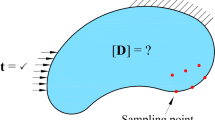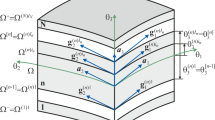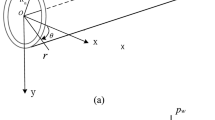Abstract
A methodology for the geometrically nonlinear analysis of orthotropic shells using a rotation-free shell triangular element is developed. The method is based on the computation of the strain and stress fields in the principal fiber orientation of the material. Details of the definition of the fiber orientation in a mesh of triangles and of the general formulation of the orthotropic rotation-free element are given. The accuracy of the formulation is demonstrated in examples of application.
Similar content being viewed by others
References
Ugural AC (1981) Stresses in plates and shells. McGraw-Hill, New York
Nay RA, Utku S (1972) An alternative to the finite element method. Var Methods Eng 1(3): 63–74
Barnes MR (1977) Form finding and analysis of tension space structures by dynamic relaxation. PhD thesis, Department of Civil Engineering, The City University, London
Hampshire JK, Topping BHV, Chan HC (1992) Three node triangular elements with one degree of freedom per node. Eng Comput 9: 49–62
Oñate E, Cervera M (1993) Derivation of thin plate elements with one degree of freedom per node. Eng Comput 10: 543–561
Brunet M, Sabourin F (1994) Prediction of necking and wrinkles with a simplified shell element in sheet forming. In: Kröplin B (ed) Proceedings of the international conference of metal forming simulation in industry II, pp 27–48
Oñate E, Zárate F (2000) Rotation-free triangular plate and shell elements. Int J Numer Methods Eng 47(1–3): 557–603
Oñate E, Cendoya P, Miquel J (2002) Non linear explicit dynamic analysis of shells using the BST rotation-free triangle. Eng Comput 19(6): 662–706
Rojek J, Oñate E, Postek E (1998) Application of explicit codes to simulation of sheet and bulk metal forming processes. J Mater Process Technol 80–81: 620–627
Flores FG, Oñate E (2001) A basic thin shell triangle with only translational dofs for large strain plasticity. Int J Numer Methods Eng 51: 57–83
Flores FG, Oñate E (2005) Improvements in the membrane behaviour of the three node rotational-free bst shell triangle using an assumed strain approach. Comput Methods Appl Mech Eng 194: 907–932
Oñate E, Flores FG (2005) Advances in the formulation of the rotation-free basic shell triangle. Comput Methods Appl Mech Eng 194: 2406–2443
Cirak F, Ortiz M, Schröeder P (2000) Subdivision surfaces: a new paradigm for thin-shell finite element analysis. Int J Numer Methods Eng 47: 2039–2072
Cirak F, Ortiz M (2001) Fully c 1-conforming subdivision elements for finite deformation thin-shell analysis. Int J Numer Methods Eng 51: 813–833
Brunet M, Sabourin F (2006) Analysis of a rotation-free shell element. Int J Numer Methods Eng 66: 1483–1510
Flores F, Oñate E (2007) A rotation-free shell triangle for the analysis of kinked and branching shells. Int J Numer Methods Eng 69: 1521–1551
Linhard J, Wnchner R, Bletzinger KU (2007) Upgrading membranes to shell. The CEG rotation-free shell element and its application in structural analysis. Finite Element Anal Des 44: 63–74
Gärdsback M, Tibert G (2007) A comparisson of rotation-free shell element for unstructured meshes. Comput Methods Appl Mech Eng 196: 5001–5015
Simo JC, Rifai MS, Fox DD (1990) On a stress resultant geometrically exact shell model. Part IV: variable thickness shells with through-the-time-thickness stretching. Comput Methods Appl Mech Eng 81: 91–126
Büchter N, Ramm E, Roehl D (1994) Three-dimensional extension of nonlinear shell formulation based on the enhanced assumed strain concept. Int J Numer Methods Eng 37: 2551–2568
Pimenta PM, Campello EMB, Wriggers P (2004) A fully nonlinear multi-parameter shell model with thickness variation and a triangular shell finite element. Comput Mech 34: 181–193
Zienkiewicz OC, Taylor RL (2005) The finite element method for solid and structural mechanics, 6th edn. Elsevier, Amsterdam
Valdés JG (2007) Nonlinear analysis of orthotropic membrane and shell structures including fluid–structure interaction. PhD thesis, Technical University of Catalunya. http://www.tdcat.cesca.es/TDX-1126107-193535
Clemente R (2007) Structural analysis of historical buildings with localized crack models. PhD thesis (in spanish), Technical University of Catalunya (UPC)
Simo JC, Fox DD, Rifai MS (1990) On a stress resultant geometrically exact shell model. Part III: Computational aspects of the nonlinear theory. Comput Methods Appl Mech Eng 79: 21–70
Kreja I, Schmidt R, Reddy JN (1997) Finite elements based on a first-order shear deformation moderate rotation theory with applications to the analysis of composite structures. Int J Nonlinear Mech 32(6): 1123–1142
Reddy JN (2004) An introduction to nonlinear finite element analysis. Oxford University Press, Oxford
Author information
Authors and Affiliations
Corresponding author
Rights and permissions
About this article
Cite this article
Valdés, J.G., Oñate, E. Orthotropic rotation-free basic thin shell triangle. Comput Mech 44, 363–375 (2009). https://doi.org/10.1007/s00466-009-0370-y
Received:
Accepted:
Published:
Issue Date:
DOI: https://doi.org/10.1007/s00466-009-0370-y




